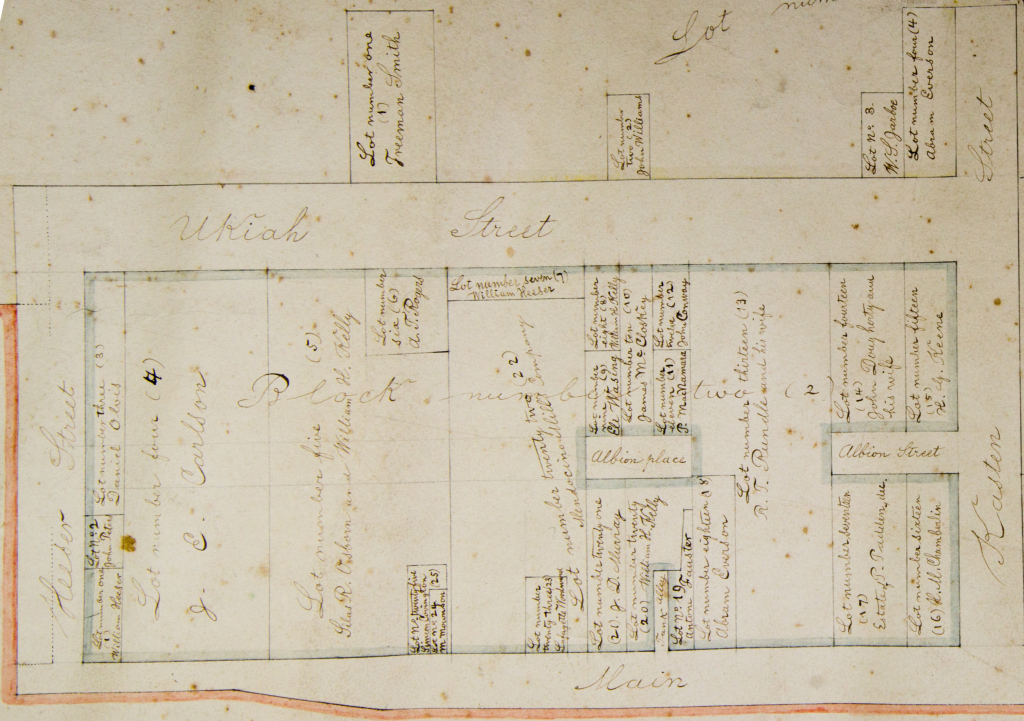I was walking down Calpella Street toward the ocean last week when I crossed Woodward Street, Heeser, Rundle, and finally Kelly. Heeser and Kelly I know, but who were Woodward and Rundle? Coming back on Ukiah Street, I encountered Osborn and William. Locals know that, with a few exceptions, the north-south streets in Mendocino are named after early settlers and the east-west streets after nearby places. But how many of us know much about the men (Mendocino’s original old boys’ club) whose names our streets bear?

A section of William Heeser’s 1868 map of Mendocino.
A couple hours in the Kelley House archives shed light on all the names, most of which belonged to guys who were in the right place at the right time. I’ll start with the most heavily traveled streets. William Kasten was a shipwrecked German sailor (or maybe he fell overboard or jumped ship) who lived on the bluffs north of Big River. He was there when the gentlemen described below arrived and claimed he “owned” all the land. Little more is known about him as he moved on in a couple years when Mendocino got “too crowded.”
Jerome B. Ford was the agent for the owner of the brig Frolic, which ran aground near what is now Point Cabrillo in 1850; he was sent here in 1851 to salvage the cargo and couldn’t help noticing the big redwood trees. He returned to San Francisco and reported them to his boss, who ordered mill works from New England. Ford returned on foot with oxen and purchased his home site from Kasten.
David F. Lansing was the captain of the brig Ontario, which in 1852 brought the first sawmill and a work crew of 40 men to run the mill. Recognizing a golden opportunity when he saw it, Lansing abandoned his seagoing life and settled in Mendocino, holding various positions in the lumber company and buying (again from Kasten) most of the land east of what is now Lansing Street.
Also on the Ontario were Edwards C. Williams, and William H. Kelly. Williams and Ford were partners in the establishment of the Mendocino Lumber Company, and they acquired full ownership of the company in 1855. Williams ran it after Ford’s death until C.R. Johnson (of Fort Bragg fame) bought him out in 1906. On all the early maps (and even some current ones) of Mendocino, Williams Street is spelled correctly. At some point, the Mendocino County Department of Transportation misspelled the name on the street signs.
Kelly, who had served as the Ontario’s carpenter, worked briefly for the lumber company, but soon got involved in business ventures that included a general merchandise store, a saloon, a livery stable, sawmills up the coast, and real estate. He purchased a big chunk of Mendocino from Kasten. During most of his lifetime, he spelled his name Kelly, but his daughter, Daisy MacCallum, added the extra e later for reasons best left for another column.
William Heeser arrived in Mendocino in 1857, and in 1858 bought from Kelly most of the land west of Lansing Street. He operated a general store, founded the Mendocino Beacon, started a couple of banks, and, as a land surveyor, mapped most of Mendocino in 1868, naming many of its streets. He built a number of roads to connect Mendocino to other cities, chiefly Little Lake to Willits and the Comptche-Ukiah, on which he collected tolls.
Richard T. Rundle had been a lumber ship’s captain in the Great Lakes who came to California and worked the gold fields for a short time with Matthew Turner. By 1854, he had opened a trading post near Noyo and joined up again with Turner to operate a lumber-shipping business between Mendocino and San Francisco. Along with William Kelley, Rundle started the first sawmill in Caspar in 1861.
Lafayette Woodward was the first postmaster in Mendocino, serving from 1858 to 1867; the post office was in the front part of his general store located on the north side of Main Street between Kasten and Osborn Streets. Silas Osborn, along with Fred Heldt, established the first saloon and hotel on the corner of west Main Street and—no surprise—Osborn Street. Osborn may not have been of quite the same caliber as the other luminaries, but he was generous with his pours.
If you would like to know more about any of these characters, contact the Kelley House curator (curator@kelleyhousemuseum.org) and arrange a time to drop by. The Kelley House Museum is open from 11:00 AM to 3:00 PM Thursday through Sunday. Walking tours of the historic district depart from the Kelley House regularly; for the tour schedule, visit www.kelleyhousemuseum.org.